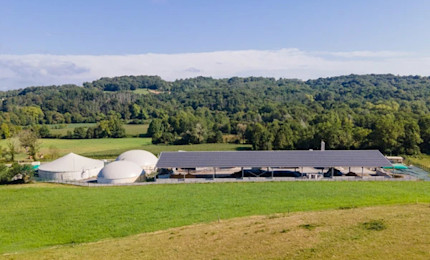Urgence gaz 0 800 028 800

What is methanation?
As an energy infrastructure provider, Teréga is helping to deploy green gases, such as
biomethane and hydrogen, to speed up the energy transition. At the same time, Teréga is
playing an active role in developing new processes that can be used to produce renewable
or low-carbon synthetic methane by methanation, offering an essential complementarity to
the energy mix of the future.
The methanation process
Methanation is an industrial process that recombines hydrogen principally produced by
the electrolysis of water, from renewable electricity or low-carbon sources, and biogenic CO
2produced by capture, purification, methanisation, pyro-gasification or hydrothermal
gasification processes to form synthetic methane. The renewable or low-carbon gas
obtained can be injected into transport grids and used for all habitual purposes (mobility,
domestic uses, industrial or storage processes).
There are two types of methanation technologies:
Catalytic methanation, a continuous reaction allowing the formation of CH 4 from H 2 , CO 2 and/or CO due to the presence of a physicochemical catalyst, at high temperatures of between 200°C and 600°C, and pressures of between 1 and 15 bar.
Biological methanation, a continuous reaction occurring in an anaerobic atmosphere in the presence of H 2 , CO 2 and/or dissolved CO in an aqueous phase, in the presence of microorganisms, at temperatures of between 35°C and 65°C and pressures lower than 10 bar.

Source : Recherche & Innovations, État des lieux des technologies de gaz verts, GRDF, 2024
Inputs : where does CO2 come from ?
A natural process that consists in recycling organic waste and breaking down plant and animal matter in an oxygen-deprived atmosphere to produce biogas (60% biomethane and 40% biogenic CO2 ). After the biogas is purified, the biomethane is injected into grids and the CO2 can be used for methanation.
A thermochemical conversion process that can be used to produce gas from waste or a waste mix and with a mandatory humidity level of between 50 and 80%. It can be used to produce syngas as well as to recover from metals, minerals, nitrogen and water that can be used by other sectors. The CO2 and CO in the syngas can be recovered by methanation.
Inputs : where does renewable H2 come from ?
From methanisation to methanation

A local gas and greater grid complementarity
Methanation will play a key role in future multi-energy systems. It allows different energy grids to be planned and managed together to ensure they complement one another, provide efficiency and avoid energy losses. It is also known as Power-to-Methane as it transforms electricity into methane.
Due to this technological tool associated with the pyro-gasification and hydrothermal
gasification sectors, as well as the capture of CO2, territory residues and waste, low-carbon
electricity and even industrial emissions are recovered to create a gas energy on a whole
new scale that is local, renewable and low-carbon.
In the current environmental and political context, the recycling of waste, energy sovereignty
and security of supply are primordial. Methanation is notable for ensuring sector coupling
within a smart, local, sustainable and non-relocatable ecosystem.
Accelerating Development of the methanation sector with Teréga
Teréga is working to accelerate the development of renewable methane by focusing on the
compatibility of its injection into grids and by working closely with project owners. In addition
to being low carbon, this gas comes from a production method that helps fight greenhouse
gas emissions. This means that methanation allows the energy production efficiency of a
methanisation plant to be increased, reducing its greenhouse gas emissions at the same
time.
Teréga is actively involved in collaborative projects aimed at the production of renewable
methane by different processes on an experimental scale, but also on a semi-industrial and
industrial scale. The goal is to encourage the development of the methanation sector to
increase the attractiveness of the renewable gas sector and to respond to the challenges of
ecological transition.
Collaborative projects on a semi-industrial scale:
the SOLIDIA platform: located in the heart of our area, in Bélesta-en-Lauragais, its
aim is to host pilot semi-industrial purification or methanation research programmes
for the enrichment of raw biogas;DEMETHA : biological methanation pilot;
METHAMAG : catalytic methanation by magnetic induction pilot;
SOLARVI : electrolytic hydrogenation pilot.
… on an industrial scale:
Jupiter 1000 : industrial Power-to-Gas demonstrator including a catalytic methanation
stage.
Development prospects
Methanation is at the forefront of the French environmental and energy management
agency’s (Ademe) “Transitions 2050” and négaWatt 2022 prospective scenarios.
From 2028, Power-to-Methane units could be systematically installed at methanisation
facilities and Power-to-Methane could represent up to 25 % of gas consumption by 2050 (36
Twh PCI).
Relying on the high storage capacity and flexibility of gas infrastructures, many European
countries have already initiated research into
Power-to-Methane, with more than ten methanation demonstrator references, in particular
the Store&Go project (Germany, Switzerland, Italy). Power-to-Methane
commercial units were also set up, such as Hitachi Zosen INOVA’s Limeco project
(Switzerland) since 2022, and Nature Energy’s Power-to-X project
(Denmark) in 2023.
Contact us
Do you have a methanation project? Or would you simply like to find out more? We can
support you and help you to ensure compatibility and inject this new gas into your grid.
Christelle ROUSSET
+33 6 72 55 32 30
christelle.rousset@terega.fr
Guilhem CAUMETTE
+33 6 22 41 74 01
guilhem.caumette@terega.fr








